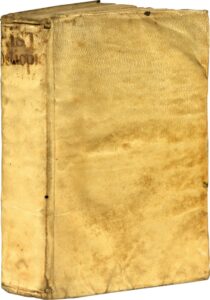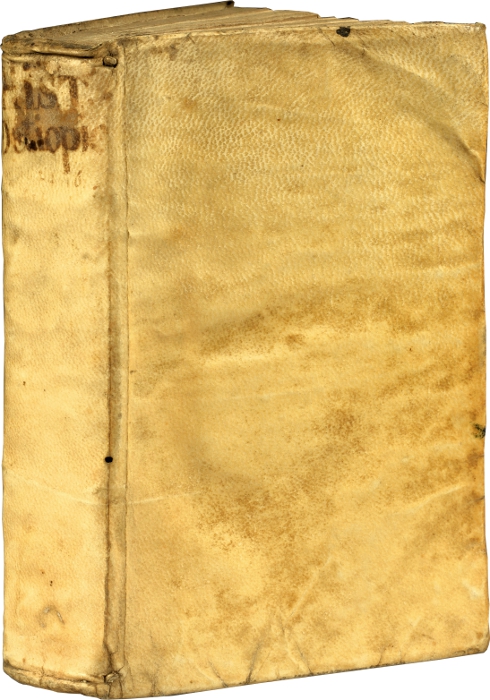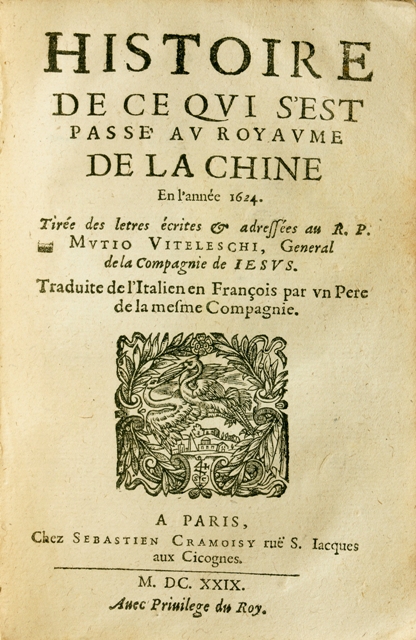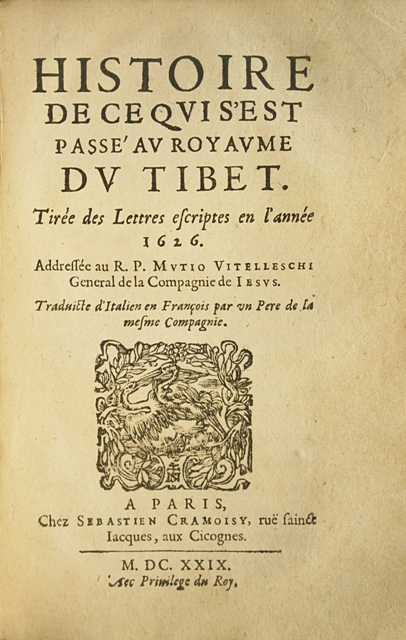Paris, Sébastien Cramoisy, 1629.
3 works bound in one 8vo volume [168 x 108 mm] with: I/ (4) ll., 262 pp. wrongly numbered 252, (1) bl.l.; II/ (2) ll., 102 pp., (1) bl.l.; III/ (4) ll., 104 pp. Full contemporary limp vellum, flat spine with handwritten title. Contemporary binding.
I/ First edition of the French translation of these accounts written by the Jesuits Gaspar Paez (for 1624 and 1625) and Alphonse Mendez (for 1626) sent on a mission to Ethiopia. Sommervogel, Bibliothèque de la compagnie de Jésus, V, 258; Carayon 906. Unknown to Chadenat, Brunet and Barbier.
II/ First edition of the French translation of these letters sent from China by Father Mutio Vitelleschi, general of the Society of Jesus. Cordier, Bibliotheca Sinica, 815; Chadenat 4896.
Due to his support to the Jesuit missions in the Far-East, it is while Vitelleschi was “in office” that Jesuits knew their golden age in China. The letters of this collection, written by a religious, explain what happened in the Jesuit missions in China in 1624. The author of this account is probably Wencelas Pantaleon Kirwitzer since he signed the last letter. However the present work has been sometimes attributed to Father Darde or Father Jên-Baptiste Machault. The first two chapters give a global vision of the political situation in China and of the progress of the Christian religion in this country at that time. The other letters talk about the situation of the various missions settled across the whole country.
Kirwitzer is an astronomer and a mathematician who joined the Jesuits in 1606. He went in mission to Asia with other Jesuits in 1618, stayed in Goa and in China, where he died in 1626.
“Peculiar and rare collection.” (Chadenat)
“I think I can attribute this translation to Father Darde… However it could be from Father J.-B. de Machault.” (Sommervogel)
III/ First French edition of the letter written from Tibet by Antonio de Andrade, dated from the 15th of August 1626. Streit V, 310; Cordier BS 2901.
Antonio de Andrade, was born in 1580 in Oleiros (Portugal) and he died (poisoned) on the 19th of March 1634 in Goa; he was a Jesuit Portuguese priest, and a missionary in India and Tibet. “He was originally noticed for his smart mind and the maturity of his judgment; at lêst it is what Borbosa says. Soon he went to the missions in India, and he arrived in Goa in the first yêr of the seventeenth century. Appointed superior of the Mughol mansion, he lêrnt there there were in Tibet some shadows of Christianity; or rather he knew exterior forms of the cult of Buddha which struck many travelers with such big surprise by their analogy to our cult. Antonio de Andrade did not hesitate to undertake a very long trip; he worn the Mughal outfit, and went towards Tibet. What he had to suffer of privations during this difficult trip would be too long to tell: it is enough to say that in those mountainous lands dividing India and Tibet, he had to brave a cold sharp enough to freeze completely his tiptoes. He finally arrived to Caparanga in 1624, a city which was the place of residence of the military chief of Tibet. It is affirmed that he prêched the Evangelium and could even build a temple to the Virgin, in which the high up in the court did their duty by helping him: what is certain is that he went back to the Mughal, to look for evangelical workers, and that he went a second time to Tibet where he was received with as much attentiveness as the previous time. It was when he was elected provincial representative of the Goa residency, then deputy of the Holy Office. Barbosa claims that the Jews from Goa administered to him a subtle poison, of which he died.” (Biographie générale, II, 545)
Therefore Antonio de Andrade was the first Europên to cross the Himalaya, in 1624. We will have to wait two centuries to see another Europên entering the town of Caparangue. He founded in 1626 the Jesuit mission in Tibet and built the first Christian church in Tibet. He dates his relation from the 26th of August 1626, the date on which the construction of the church was finished. He describes in his account the religious and social customs in Tibet at that time, as well as the Buddhist ceremonies.
Carl Ritter wrote since 1833: “Special value attaches to the artless and candid narrative from the fact that the book is rare, that the enterprise was remarkable, and that this geographical source has been left unused for two hundred yêrs; it opened up a mountain region, which recently has had to be scientifically rediscovered.” (Die Erdkunde von Asien)
A precious copy of this collection of three Jesuit letters of the utmost rarity, written in Ethiopia, China and Tibet, preserved in its original contemporary limp vellum binding.




